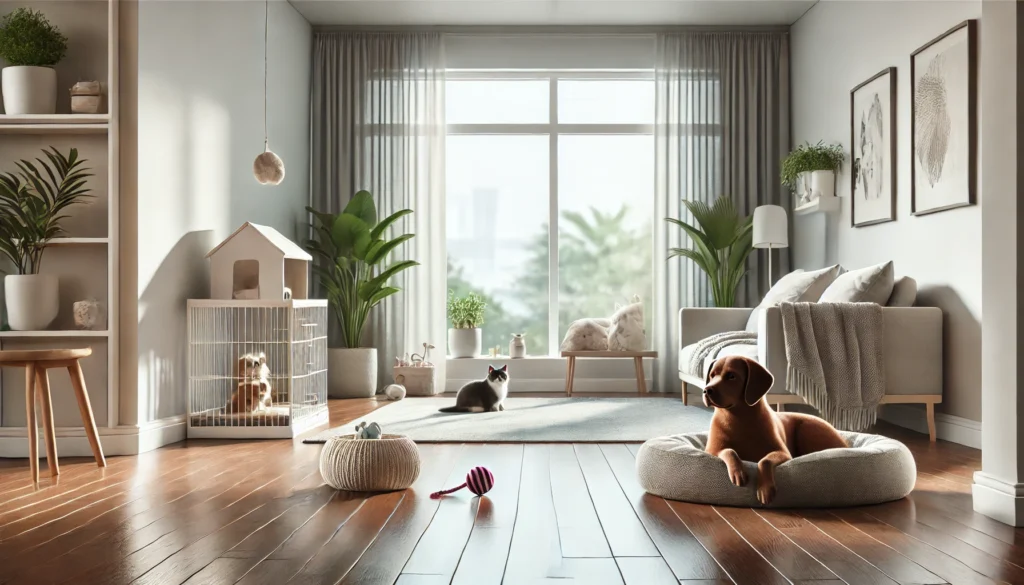Indoor life provides comfort and safety, but for many dogs and cats—especially rescues or those with anxiety—it can take time to feel truly secure. Helping your pet feel safe is about building trust, creating routine, and making sure their environment supports emotional well-being.
Aqui estão estratégias práticas para promover segurança e confiança em pets que vivem dentro de casa.
Create a Safe Zone
Every pet should have a space they can call their own.
- Choose a quiet corner or room where your pet can relax undisturbed.
- Place a soft bed, blanket, and a few favorite toys in that space.
- Avoid high-traffic areas or locations with loud noises.
This gives your pet control over their environment and a sense of retreat when things feel overwhelming.
Keep a Consistent Routine
Pets feel safer when they know what to expect.
- Feed at the same times daily.
- Keep walks, playtime, and bathroom breaks on a schedule.
- Clean litter boxes and change water bowls routinely.
A consistent routine provides structure and reduces anxiety.
Speak in a Calm, Reassuring Voice
Your tone matters just as much as your words.
- Use soft, gentle speech around your pet.
- Avoid shouting or sudden loud noises.
- Use your pet’s name in a positive way to create familiarity and trust.
Calm communication helps pets feel secure and connected.
Let Your Pet Approach You
Especially with shy or new pets, let them set the pace.
- Sit quietly and allow them to come to you.
- Offer your hand for sniffing rather than reaching over them.
- Reward brave behavior with treats and praise.
Building confidence happens step by step.
Avoid Forced Interactions
Don’t push your pet into situations before they’re ready.
- Let them explore new areas slowly.
- Allow them to observe visitors before interacting.
- Never force play, cuddling, or being picked up.
Respecting their boundaries shows them they’re safe with you.
Use Positive Reinforcement
Encourage good behavior and bravery with rewards.
- Use treats, toys, or gentle praise to reinforce calm behavior.
- Reward your pet when they try something new or remain calm in a stressful moment.
- Be consistent — every small win counts.
This builds trust and helps reduce fear responses over time.
Provide Enrichment Without Overstimulation
Stimulation is important, but so is balance.
- Offer toys, scent games, and puzzle feeders in moderation.
- Limit noisy or flashing toys, especially for nervous pets.
- Ensure rest areas are quiet and separated from activity zones.
A peaceful environment supports emotional regulation.
Watch Body Language for Cues
Learn how your pet expresses stress or fear.
- Dogs may show tucked tails, yawning, panting, or turning away.
- Cats may flatten ears, flick tails, or hide under furniture.
By noticing signs early, you can de-escalate situations before they worsen.
Gradually Introduce New Experiences
Help your pet build confidence through small exposures.
- Let them explore a new room with supervision.
- Introduce new sounds gradually, like the vacuum or doorbell.
- Offer rewards for calm behavior during new experiences.
Over time, these small wins build a confident and well-adjusted pet.
Be Patient and Present
Trust takes time — especially for pets who have experienced trauma or change.
- Sit near them, even if they aren’t ready to cuddle.
- Observe without overwhelming.
- Celebrate small progress steps like approaching you or using a new toy.
Every gesture of respect strengthens your bond.
Helping your pet feel safe indoors is about creating a world where they know they’re loved, protected, and free to be themselves. With time, trust, and thoughtful care, your pet can go from fearful to flourishing — right in the comfort of home.






